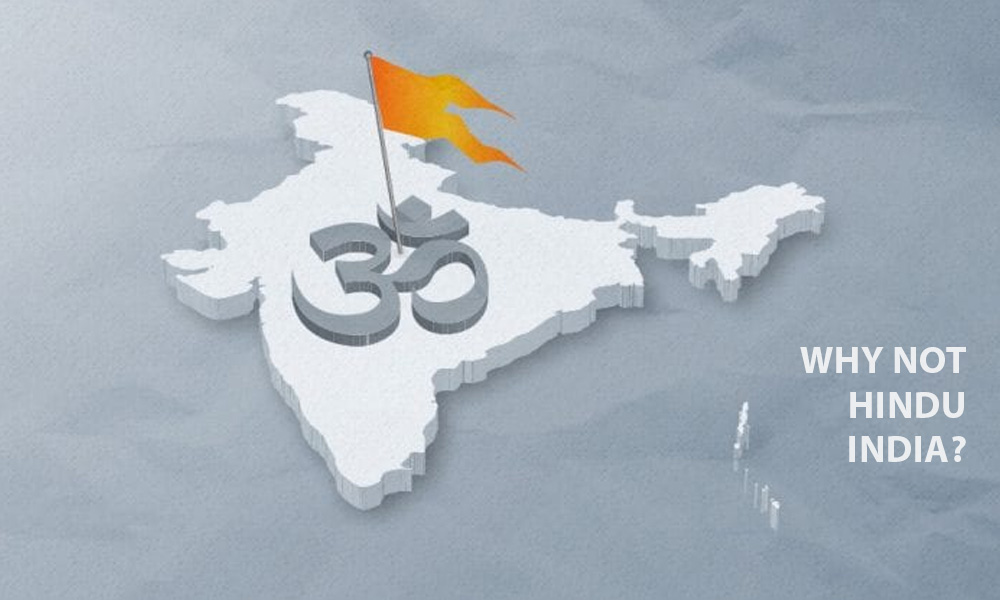Hinduism
Hindus Must Unite or Face Extinction
Published
5 years agoon
By
Vedic Tribe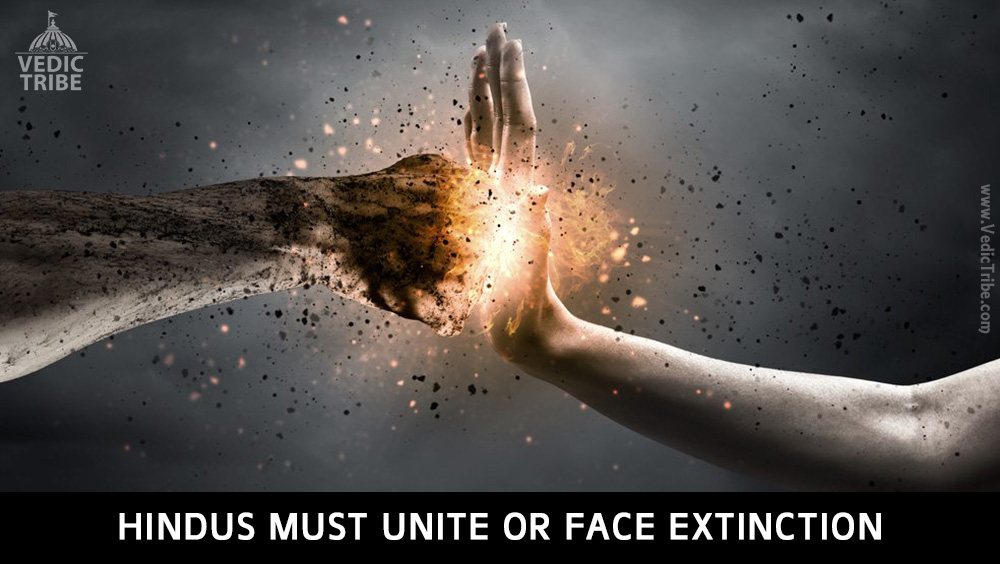
~ By Stephen Knapp
The typical Indian mentality and the path of Hinduism, or the Vedic path of spiritual progress, is one of great individuality and freedom for each person to decide what they want or what is best for their own spiritual development. Thus, it is typical for Hindus to work on their own, not necessarily as a group. There is nothing wrong in that. It is the last of the great cultures that promote the utmost freedom for the individual. But, yet, there is a great need that is not being met, and that is the need for Hindus / Dharmists / Devotees, especially in India, to unite and work together as a group, or even as a whole society, in order to continue to preserve and protect their own culture, traditions, and certainly the freedom of the individual.
This freedom is being threatened in many ways today, although there are those who either refuse to admit it, refuse to see it, or are hesitant to work together to save it. This blindness and hesitancy must be overcome.
Throughout India, for example, there are portions of the population that belong to particular religions, such as Muslims, Christians, Sikhs, Buddhists, etc., and they often work as a strong section of society to protect their rights, freedoms and traditions. Especially Christians and Muslims vote as a block to promote and vote into office particular politicians they favor, and who favor them. They also will create an uproar when something happens against them, or when someone desecrates their religious texts. They hold demonstrations or even riot when a mosque is threatened. Thus, they get there way, or at least people begin to hesitate before doing something that will make them upset.
However, it seems that the Hindus are the most apathetic in this regard. Though they are increasingly beginning to wake up to the importance of being heard and making themselves be noticed, they are still, for the most part, letting their influence and the power of numbers that they have as the majority of the Indian population simply slip through their fingers.
It is time we learn that apathy is a disservice to Dharma and society. It accomplishes nothing, if that is not obvious. It lets the needs of the Dharmic society go unnoticed. The point is, if we do not take care of ourselves, no one else will. And there are people counting on that apathy to get their way and do things against the well-being of the majority Hindu population. And we are letting them get away with it. This hurts those who follow Vedic Dharma, and takes away the confidence that people need to maintain their practice of the Dharma.
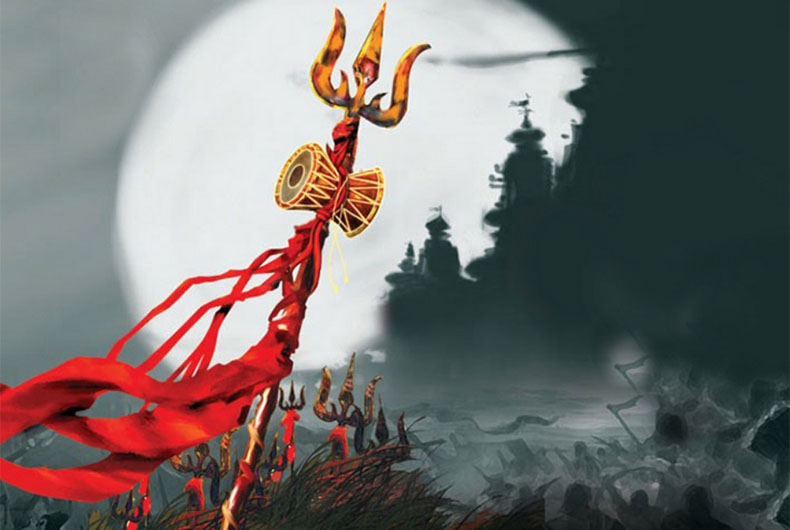
Those who say that Sanatana-dharma is eternal and, thus, there is no need to worry about the future, do a great injustice to the Vedic cause and to humanity. Those who say that Vedic culture has lasted for thousands of years and will continue to last for thousands more show a poor excuse for apathy. Though it is eternal, which is the meaning of Sanatana, this does not mean that it will always remain a prevalent force on the face of the earth. It can also decline into obscurity if we let it.
Those who feel that there is nothing to worry about need to understand why the Bhagavad-gita was spoken. Arjuna did not want to fight, and who does? No one wants war, at least if they are in their right mind. But how many people of particular religions cry for war, or jihad, toward anyone who is not a part of their religion? Arjuna wanted to leave the battlefield and go to the forest to meditate, as if that would solve all of his problems. But Lord Krishna said he was acting foolishly. Lord Krishna told Arjuna that he should indeed fight, but fight for what? He was to fight to uphold the Dharmic principles that the Kauravas were neglecting. Lord Krishna specifically went to the Kauravas to try and arrange a diplomatic means to keep everyone happy and prevent war, but they would not listen. Finally, there was no alternative but to fight. And so the sides were drawn against those who fought for Dharma and those who fought for their own agenda.
We could also say that we should simply let the good Lord take care of everything. If something is meant to be, then the Lord will take care of it. But that is not the result nor the premise of the Bhagavad-gita. Lord Krishna showed that everything may rest on Him as pearls are strung on a thread, but we all must do our part. It is up to us to protect Dharma if we are indeed expecting to continue to have the freedom to practice and follow it.
Vedic culture has been attacked for the last 1200 years. India’s history can easily show that. And it was the heroes of India, and the millions of average everyday people of India, Hindus, who gave their lives and underwent severe torture that kept Vedic Dharma alive for future generations, and for the freedoms that we have today that allow us to continue these traditions. Are we now to let those freedoms die, after so many sacrificed their lives for us, for Vedic Dharma? This would be a great dishonor to their memory and for the cause they fought for. We cannot allow this to happen, but we also need to be aware of the warning signs of what is happening around us.
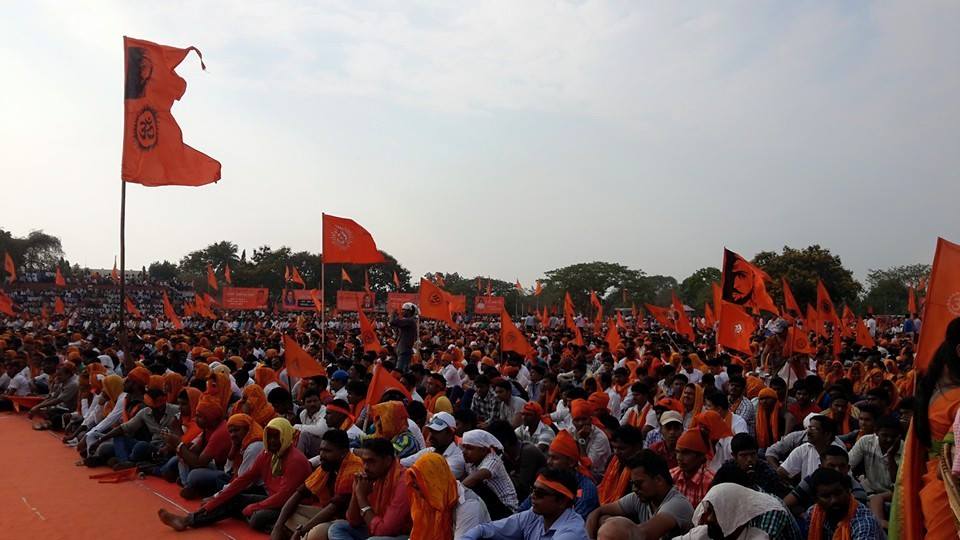
This is why, with a growing Muslim population in India, and all over the world for that matter, Hinduism in India could be dead in another 100 years. Just by their high birth rate alone Muslims are increasing their presence in India. Thus, one hundred years from now Vedic Dharma may only be practiced in small pockets here and there, such as in various holy places, as long as the majority Muslim population allows it. The fact is that history has shown that Muslims have a very low tolerance for anything that is non-Muslim. You can see this in the ever decreasing non-Muslim population in Pakistan, Bangladesh, Afghanistan, Arabia, etc., etc. They have never allowed complete freedom for non-Muslims in any Islamic country, and have passed laws against them and persecuted them and destroyed their temples and monuments, kidnapped and raped their women, and killed thousands of Hindu or Christian men. So, why should we expect India to be an exception? They have already shown what they did in India.
A rising Muslim minority in India does not have to become a majority to begin changing laws in their favor, but simply by being a noisy and disturbing minority they will gain the upper hand. Increasing their political maneuvering will give them political clout and power. And when they do come closer to being a majority, they will certainly increase the persecution of an infidel Hindu population until they are finally extinct.
Over 400,000 Hindu Pandits were chased out of Kashmir, and what was done about it? Take notice of how Assam is becoming the new Kashmir with nearly 80,000 people being displaced, having left their villages due to fear from the incoming and growing Muslims. And now the Muslim political party in Assam is demanding a separate and autonomous region in southern Assam just for Muslims. Is this not the same pattern we have seen time and time again? And is anyone doing anything about it? Is anyone speaking out that another chunk of India is threatened with being lost? In due course, what will be left of India if this keeps happening?
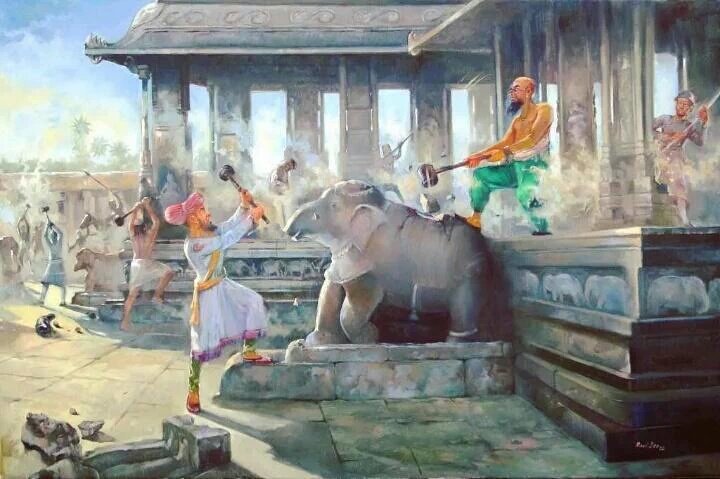
Even now the Muslims of India, though they have a Hindu ancestry, no longer identify themselves as Indians but as members of the house of Islam. Thus, they are only taking care of unfinished business from their previous invasions and war against Hindus. Hindus often do not conduct themselves in a powerful way. And when they do, the Indian media is completely against them. The secular media in India does not mean secular, it means to bend over backward showing preference for the minorities at the expense of the Hindu majority. Thus, secular media in India means to be anti-Hindu. But should that stop Hindus? They cannot afford to be overly considerate of what others think when their own future is at stake.
The next ten to 15 years will be a major turning point and show the deciding factor for the future of Vedic Dharma on the face of the planet, particularly in India. The thing is, even now we practically have more freedom to practice Vedic culture in America than we do in India, in its own homeland. Will America be one of the final strongholds for Vedic Dharma? Will we have to one day export it back to India from America?
Therefore, we have to ask ourselves, will our temples still be here in India in another 40 to 50 years? Or will they gradually disappear because of Christian conversion tactics, Muslim persecution against Hindus, or because corrupt politicians who care little about Vedic culture take over temples to possess and sell their assets for the money? Hindu temples are known for being income producers, for the most part. While the Indian government cares little about possessing churches and mosques because they need funds, they use more money than they bring in. It is the temples that are income producers because of the Hindu majority population that give to them.
Therefore, there is no doubt that Hindus must unite as a society while there is still time to make a difference.
CHANGES THAT NEED TO TAKE PLACE
The time to act is now. Some of the things Hindus / Dharmists / Devotees need to do include:
1. Hindus must unite and vote as a bank in all elections to oust those who disregard Hinduism and vote in those who do. They must never take an election for granted. They have done so in the past with terrible results.
2. Hindus must get involved in politics in various ways to help direct the actions of the government.
3. India must also change its politicians in order that it as a nation takes a stronger stance against those who try to bring India down, and to take a stronger stance to defend itself militarily. India cannot afford to be a wimp. There is a need for younger leaders who are more aware of how to fulfill the needs of India.
4. Hindus must work to unite all Hindus. They must wake up other Dharmists about the need to take action. This may be a daunting task, but let everyone become involved in the action plans that will make a difference for their future, for their culture, for preserving their tradition, for protecting the rights and freedoms of the individual, and certainly for the well-being of their children. Work for the freedom to continue to construct and manage their own temples without interference from the government.
5. The spiritual leaders and acharyas must reach out to the villagers and people of all classes in order for the people to feel cared for, and that they are a part of and belong to the Dharmic tradition and are welcome in the temples. They should feel that they are not neglected, but that they are wanted and needed in the greater cause for Vedic Dharma.
6. Indian Hindus must take care of their own people, those who are poor, destitute and disadvantaged, or others will. And those others are often quick to try to convince them of the shortcomings of Hinduism, and, thus, through the guise of welfare activities, try to convert the poor into leaving Vedic Dharma and become Christians or something else. It is true that those who convert for material facility are not strong converts because they could just as easily convert back to what they were once their financial status improves. However, if a child is converted and stays in that fold for 10 to 15 years, it is not likely they will ever want to reconvert back to Vedic Dharma after being a Christian for so long. Thus, from that generation forward, that family will likely continue to be non-Dharmists. Children of converted families who remain outside of the Dharmic fold for that length of time will have little impetus to change.
7. All Dharmists must be educated in their own culture, philosophy, and tradition to understand it clearly, and know how to explain it to their children and others. Thus, they can also be convinced of the deep and profound nature of what they already have, and be less likely to ever want to convert to something else.
8. When anything in the media appears to depict Vedic culture in a poor light, or when someone like a politician says something against one of the Vedic Divinities, there must be an immediate outrage or lawsuit established against such a person or incident. If people begin to see that an immediate and strong reaction takes place whenever Vedic Dharma is poorly or inaccurately portrayed, or when someone denigrates the Bhagavad-gita or one of the Vedic texts, they will begin to hesitate or even stop before doing such things in the future.
9. There must be regular programs at temples for the education of all, and book distribution to help spread Vedic spiritual knowledge to everyone far and wide.
10. Everyone should engage in a cultural revolution in which we promote the true understanding of Vedic Dharma. This is one of the best ways to spread the beauty and freedom found in the lofty spiritual knowledge that can attract everyone. Westerners are especially and increasingly being drawn to the beauty of this spiritual path. So, Indians should have no doubt of its potency and work to maintain India as the homeland of a dynamic and thriving Vedic tradition.
11. Dharmists / Hindus must work to do service for their temples and community to take care of everyone and maintain what they have, namely their temples, their right to peacefully observe the Vedic ways, and care for the people who turn toward the Dharmic path.
Such changes can only take place if Hindus unite and stand strong for Dharma and work together. We have to drop the apathy, discard our ego, along with ethnic and class distinctions and join together under one identity and for a primary cause. We must act like Arjuna did after having received the instructions of Lord Krishna to stand and fight for Dharma rather than going off into the forest to get away from everything and meditate, as if that would solve his dislike to do battle against those who had chosen the side of adharma.
If Hindu Dharmists do not do this, and remain as they are, being apathetic and inactive, it is but a prescription for a slow extinction. They may lose it all, certainly the freedom to choose what they want to be. Only we can change the future by being pro-active and united in this way. Then Sanatana-dharma will remain on the face of the earth as a path that we have the freedom to follow. Do we want to see Vedic Dharma as the tradition of the majority population in India in another 100 years, or will it become a thing of the past, like a museum piece? This is what has happened to the Maya, Inca, Egyptian civilizations, and many others. The choice of what happens in the future is ours by how we act and work together now.
Dharma Rakshati Rakshitah. (Dharma protects those who protect it)
Jai Sri Krishna.
You may like
-


Seven Vows and Steps (pheras) of Hindu Wedding explained
-


Sari or Saree is symbol of Indian feminism and culture
-


Atithi Devo Bhava meaning in Hinduism and India
-


Navaratri: The Nine Divine Nights of Maa Durga!
-


Significance of Bilva Leaf – Why is it dear to Lord shiva?
-


Concept of Time and Creation (‘Brahma Srishti’) in Padma Purana
Hinduism
Significance of Bilva Leaf – Why is it dear to Lord shiva?
Published
4 years agoon
March 12, 2021By
Vedic Tribe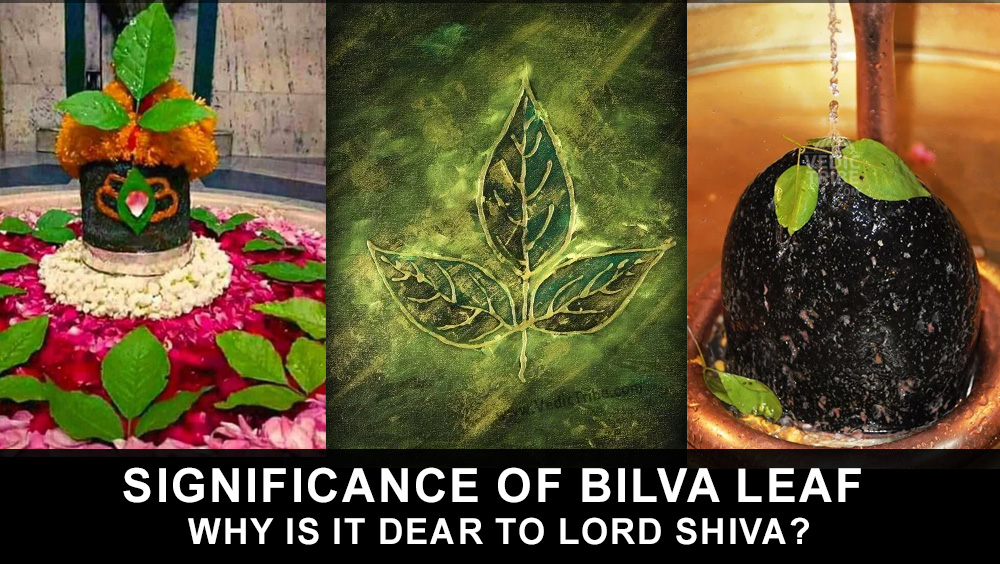
– Arun Gopinath
Hindus believe that the knowledge of medicinal plants is older than history itself, that it was gifted hundreds of thousands of years ago to the Vedic by Lord Brahma, the divine creator.
Thus when the Rishis of the Ayurveda sought to heal human suffering, they were able to draw on knowledge that had already been evolving for millennia in the forests of India. One tree about which they had a very deep knowledge was the Bilva tree. The science of Ayurveda values the Bilva highly for the medicinal properties contained in its root, fruit and leaves. According to Swami Sivananda, it is a healing tree which cures all diseases caused by vata (wind) and gives strength to the body.
More commonly known as the Bel Tree in India as well as other warm countries, this is a sacred tree having sacrificial importance and the first thing we can notice about the leaves is that they are generally trifoliate. This trifoliate leaf is symbolic of Trikaal or the Hindu Trinity of Devas known as Brahma Vishnu and Mahesh. The other names of this tree are Wood apple and its botanical name is Aegle marmilos.
The Bilva leaf or Patra as it is known, represents the Trinetra or three eyes of Lord Shiva, the main aspects like Trishakti (volition, action and knowledge), the three Shiva lingams and the three syllables of AUM or Omkar and are most favorite of Lord Shiva.
There are also five formed Bilva leaves known as PanchaDal patra found on some Bilva trees and these too are held as sacred for the worship of Lord Shiva. Bilva tree grows to a height of 8 meters with thorns. The leaves are alternate, ovate, trifoliate and aromatic. The tender leaves and shoots are consumed as salad greens. The flowers bloom in the month of May and will have a sweet fragrance.
It appears from all the Hindu texts and scriptures that the Bilva tree itself has been held very sacred and auspicious and is considered very holy since time immemorial thats its significance is mentioned in Mahapuranas in various forms of mantras. The Shiva Purana mentions a particular narration of how the usage of Bilva due to its scientific as well as medicinal properties is of great adavantage to Mankind.
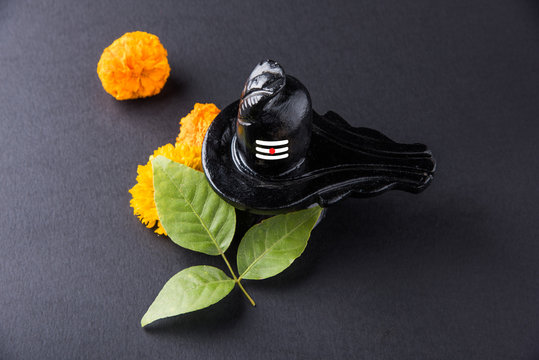
The 22nd Chapter of maha ShivaPurana narrates ” The trifoliate Bilva Patra is so sacred to Lord Shiva & is therefore a symbol of the Lord. Adored by all the Gods, its importance is difficult for anyone to comprehend. The sacred tree can only be known to a limited extent. Sacred sites of this Earth can only find their place at the root of this auspicious tree. Those who meditate upon Lord Mahadeva in His form of linga at the root of Bilva obtain Moksha & become purified souls by attaining Shiva. Such are the marvels of this sacred Bilva.”
The famous Shri Bilvashtakam (v. 6–7) Mentions :
Lakshmyaascha stana utpannam Mahaadeva sadaa priyam,
Bilva vriksham prayachchhaami eka bilvam Shivaarpanam.
Darshanam bilva vrikshasya sparshanam paapanaashanam,
Aghorapaapasamhaaram eka bilvam shivarpanam.
Translation :
Born from the heart of Goddess Lakshmi, the Bilva tree is ever dear to Mahadeva. So I ask this tree to offer one Bilva leaf to Lord Shiva. Even if (one) has darshan ( view) of the Bilva tree, and touches it, surely frees one from sin. The most terrible karma is destroyed when a Bilva leaf is offered to Lord Shiva.
It is also believed that Lakshmi, the Goddess of Wealth, also lives in the bel tree. Those who perform the puja of Shiva and Parvati devoutly, using the leaves, will be endowed with spiritual powers.
Scientific Advantages
According to Hindu scriptures, the Bilva is Triguna which is connected to the three Gunas or components of natural characteristics of the tree. In Hindu philosophy, the three Gunas are Sattva, Rajas & Tamas with Sattva being the pure most while Tamas normally is to do with darkness & ignorance.
The Sattvic component is believed to be more centered within the bilva patra and therefore the high capacity to absorb and emit Sattvic frequencies. This has various effects on the environment as well as on anyone merelt touching the leaf. One of them is the reduction of Rajasic-Tamasic atoms present in the atmosphere & more importantly within the human body.
A Sattvic leaf like bilva patra when brought in proximity of a person suffering from negative energies such as distress and anxiety is believed to medically reduce these energies within the human body. People with negative outlook towards life and their environment normally do not realize they have negative energies building up within their body and are at a risk of subconsciously harpering destructive thoughts also.
Whenever such people come into contact with a Sattvic atmosphere, what they fail to realize is their negative energies try to fight the positivity of a Sattva predominant environment. This struggle can build up at various levels and can vary from the human mind thinking negatively and can result sudden bursts of anger to destruction of things around them.
Medicinal uses
The roots, skin, fruits and the leaves of the Bilva tree are used for medicinal purpose. Bilva has astringent, edema lessening, anti-diarrhea, laxative and appetizer properties hence, can be used to cure both internal and external diseases.
The sacred tree has many medicinal usages and is advantageous in curing many human ailments such as :
- Bleeding gums.
- Bel fruit clears diarrhea, dysentry, phlegm, high blood pressure, morning sickness in pregnancy, stress.
- Asthma can be controlled when a mixture of dry bel leaf powder & honey is consumed daily
- Jaundice can be cured by consuming the extracted juice of the bilva leaves
- Anemia can be cured by drinking the powder of the bel fruit mixed with milk
- Bel fruit keeps the skin rejuvenated when pasted into a face pack; also cures joint aches
Hinduism
Concept of Time and Creation (‘Brahma Srishti’) in Padma Purana
Published
4 years agoon
March 12, 2021By
Vedic Tribe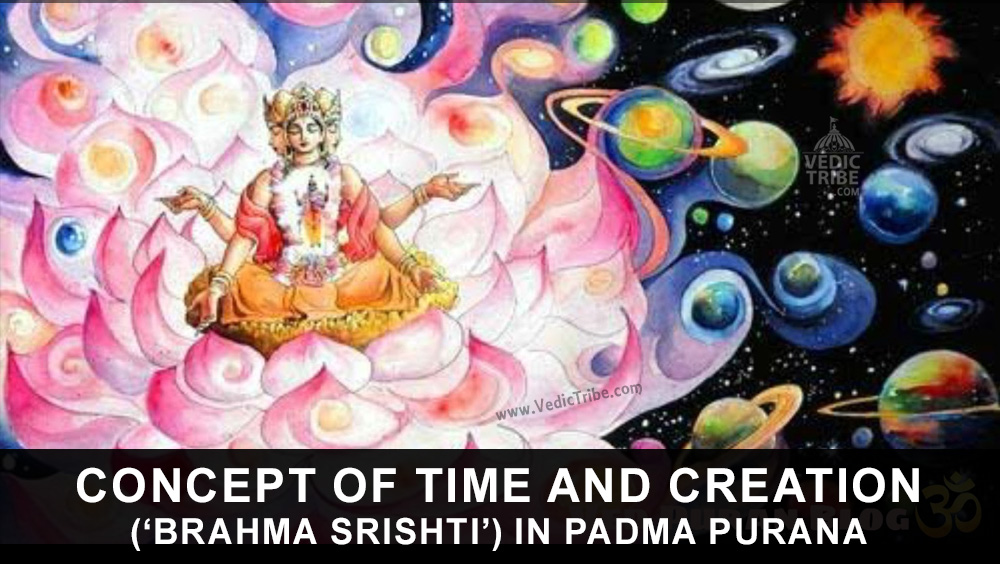
Pulastya Maha Muni affirmed to Bhishma that Brahma was Narayana Himself and that in reality he was Eternal. But in a formal sense it was stated that Brahma was ‘created’ and in that normally recognised manner Brahma had hundred years of age; apparently, the concept of Time would have to have a basis and that was why Brahma’s age was determined notionally as of hundred Brahma Years; in other words, ‘Para’or the first half was over and his present age has entered the ‘Paraartha’, the second half (viz. Fifty first year).This was how, the concept of Time emerged.
Every fifteen ‘Nimeshas’ constitute one ‘Kaashtha’; thirty Kashthas one one ‘Kala’; thirty Kalas make one ‘Muhurtha’; thirty Muhurtas make one day/night, thirty day/nights make on ‘Maasa’; (half Maasa makes one ‘Paksha’), six Maasas make one ‘Ayana’ and two Ayanas-Dakshinayana and Uttarayana- make one ‘Year’. Dakshinayana is a night for Devas and Uttarayana their day. One hundred human years make one day-night of Devas.
Twelve thousand Deva Years make four Yugas viz, Satya Yuga, Treta Yuja, Dwapara Yuga and Kali Yuga and these four Yugas make one Maha Yuga which is Brahma’s one day! Satya Yuga comprises 4800 DevaYears including ‘Sandhya mana’ of 400 years and ‘Sandhyamsha maana of additional 400 years; Treta Yuga comprises 3600 Deva Years including 600 years of ‘Sandhya/ Sandhyamsha mana’each; Dwapara Yuga of 2400 years including 200 years of ‘Sandhya/ Sandhyamsha mana’each and Kali Yuga of 1000 years including 100 years each of Sandhya / Sandhyamsha manas.Deva Years are 360 times more than human years. For instance, the duration of Kali Yuga in human year terms is 432,000 years; Dwapara’s is 864000; Treta Yuga’s is12, 96,000 and of Satya Yuga is 17, 28,000 years; all the Yugas totalling 432, 00, 00,000 (432 million) make one Chaturyuga and that constitutes one Brahma Day!
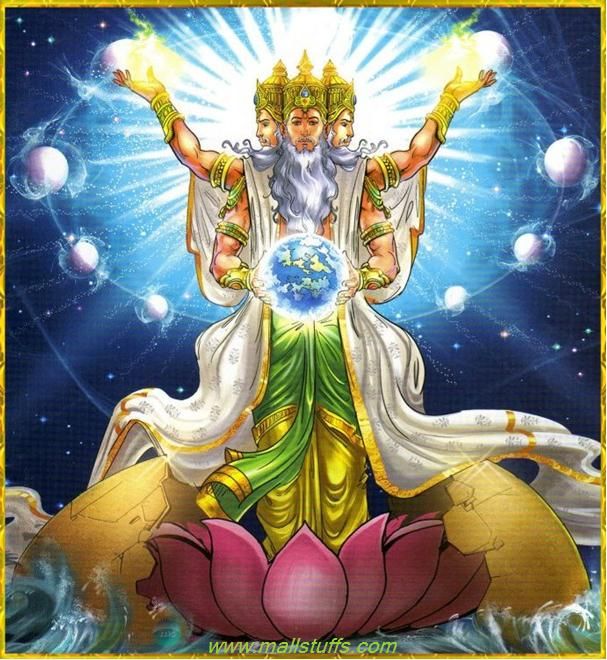
In one day of Brahma there are fourteen Manvantaras and each Manvantara has 8, 51,000 of Deva Years. There are two kalpas on one day-night of Brahma.At the end of the previous Kalpa, Brahma felt fresh from the previous night and found that Prithvi was submerged in water while Bhagavan Varaha Deva entered into water and Prithvi prayed to him; in response, Varahadeva emanated a ‘Ghur Ghur’ sound which was like the reverberation of Sama Veda, lifted up Prithvi from Rasala loka by the might of his horns, Devas rained fragrant flowers from the sky, Rishis went into rapturous tributes to Vishnu’s incarnated Varaha Rupa; and Brahma implored the latter to allow him recommence Srishti with his blessings as also to preserve and administer the Creation that he would so generate even as the Lord gracefully replied to say: ‘Tathastu!’ (So be it!).
Brahma’s first Srishti being Maha Tatva, the creation of Tanmatras was known as Bhuta Sarga or the Second Srishti; Vaikarika or Satvika Ahankara was the third Srishti of Indriyas or Aindriya Sarga; the Fourth Srishti is the Mukyha Sarga related to Mountains, Forests and other Sthaavara Srishti; the fifth Srishti relates to Pashu-Pakshi (Animals and Birds); the seventh Srishti was called Deva sarga or Urthva faced and was of Devas; and Seventh Srishti was of Manava Sarga; the Eighth was of Anugraha Sarga which could be of Satvika or Tamasic nature and finally the Ninth Srishti called the Kaumara Sarga which could be of Prakrita or Vaikrita Marg.
Depending on the carry forward of one’s own balance of ‘Papa-Punya’of the previous time-frame preceding the Pralaya, placement of lives was commenced by Brahma in the New Age. Arising out of his ‘Manasika Samkalpa’ (Mind born Proposal), Brahma created various species including Devas, Asuras, Pitaras and human beings. From his thighs, the evil Asuras emerged and as per his free will various birds were created.
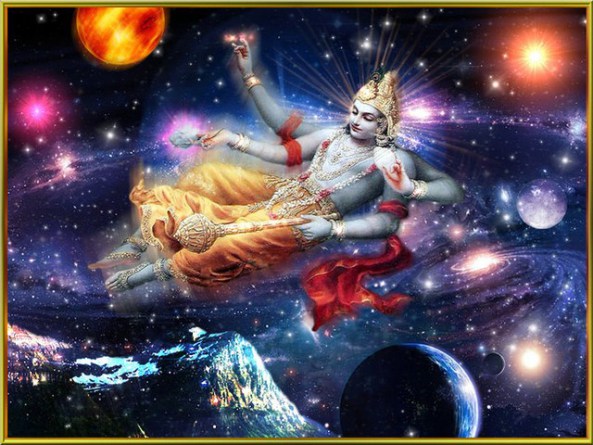
From his stomach surfaced cows, his shoulders the wolves; his face created horses, elephants, asses, nilgais, deer, camels, etc.each species multiplying several others. Brahma’s body hairs created fruits, roots and foodgrains. From his right extreme face, Brahma created, Gayatri Chhandah, Rig Veda, Tivritstoma, Rathantara, Agnihoshtha yagna; from South-faced he created Yajur Veda, Tristhub Chandas, Panchadasha stoma, Brihatsaama, etc; Sama Veda, Jagati Chhanda, Saptadashastoma, ‘Vairupa’ etc; from the Western face; Brahma created Ekavimshatstoma, Atharva Veda, Aptoryama, Anushthup chhanda, and Vairaja from the Uttaravarti Mukha. Miscellaneous ‘Pranis’ were created from any of the limbs of Brahma. To sum up thus at the beginning of the Kalpa, Prajapati Brahma created Devas, Asuras, Pitaras and human beings as also of Yakshas, Pishachas, Gandharvas, Apsaras, Siddhas, Kinnaras, Raakshasaas, Lions, Birds, Animals and Reptiles.
Focussing attention on human beings now, Bhishma asked the highlights of Varnashrama Vidhi and Pulastya Muni explained that Brahma created Brahmanas from the face, Kshatriyas from ‘Vakshasthali’ (chest), Vaishyas from thighs; and Shudras from the feet.These four Varnas are the important constituents of ‘Yagnas’; Devas are satisfied wirh their respective portions of ‘Havis’ (oblations) to Agni and being pleased with the Yagnas, Devas bestow good rains and good crops which leads to material prosperity.
The hearts and hands of every body tend to be clean and social customs and virtuous living would go hand in hand. Prajapati decided the duties of the Four Varnas, depending on the professions that human beings tended to follow like Brahmanas performing Yagnas, Vratas, Temple Tasks, and enabling various religious deeds of Virtue in favour of the members of three other Varnas etc.; Kshatriyas discharging the responsibilities of Kingship, Administration, Security against external enemies, collection of taxes and maintenance of Internal Law and Order; Vaishyas performing business, farming, trading and all matters involving finance, provision of materials to others by allowing reasonable profits for the services given etc. and Shudras supporting the members of the Three Varnas in the discharge of duties being undertaken by them.
Brahma materialised the above various kinds of Creations by applying his mental faculties but was not quite satisfied as the next generations so created were not adequate to fill in the universe; therefore he created Sages like Bhrigu, Pulaha, Kratu, Angira, Marichi, Daksha, Atri and Vasishtha, in addition to the four ‘Manasa Putras’ viz. Sanaka, Sanandana, Sanatana and Sanat Kumaras. As not all these sons were interested in family lives, Brahma created Rudra from his forehead and decided that half of the body be a woman; thus Eleven Rudras got materialised along with as many Rudranis who had a variety of Rupas ranging from ‘Sowmya’ (composure), ‘Krura’(unkindness), ‘Shanta’ (peacefulness), ‘Shyama’ (darkness), ‘Gaura’ (wheatish) and such other colours.
Further on, Brahma created Swayambhu Manu and the latter’s wife Shatarupa; the Manu couple gave birth to sons Priyavrata and Uttanapada and daughters Prasuti (married to Daksha) and Akruti (married to Ruchi Prajapati). To Prasuti and Daksha were born twenty four daughters, thirteen of whom were Shraddha, Lakshmi, Dhruti, Pushti, Tushti, Megha, Kriya, Buddhi, Lajja, Vapu, Shanti, Sidhi, and Kirthi (all these thirteen were married to Dharma); eleven more daughters were Khyati, Sati, Sambhuti, Smriti, Preeti, Kshama, Sannati, Anasuya, Urja, Swaha and Swadha; they were wedded respectively to Bhrigu, Shiva, Marichi, Angira, Pusasthya, Kratu, Atri, Vasishtha, Agni and Pitras.
The sons of Daksha’s daughters were Kamak by Shraddha, Darpa to Lakshmi, Niyam to Dhriti, Santhosh to Tushti, Lobha to Pushti, Shruta to Megha; Danda, Vinay and Naya to Kriya, Bodha to Buddhi, Vinay to Lajja, Vyavasayak to Vapu, Kshema to Shanti, Sukha to Siddhi, and Yash to Kirti.These were all the sons of Dharma. Kaam and Nandi gave birth to Harsha, the grand son of Dharma. Bhrigu and Khyati gave birth to Devi Lakshmi who was Lord Narayana’s wife. Bhagavan Rudra accepted Sati as his wife (Daksha’s daughter) but Devi Sati sacrificed her life pursuant to Daksha’s Yagna to which Rudra was uninvited but Sati insisted in attending it; she felt highly insulted by her father Daksha who also offended Rudra Deva and Rudra eventually destroyed Daksha Yagna. — with Srilan Srisukumaran.
Hinduism
Karma Yoga – Yog Through Selfless Actions
Published
4 years agoon
February 23, 2021By
Vedic Tribe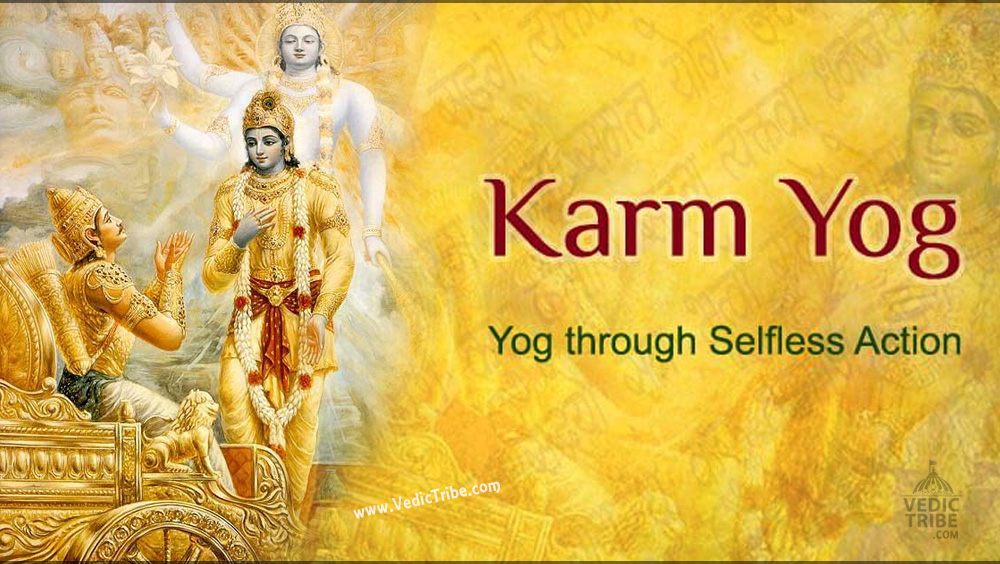
Karma Yoga is Meditation in Action:
“Karma” means action and “yoga” means loving unity of our mind with God. To perform karma and also practice yoga means to remain engaged in activity in the world while remaining in a state of devotional unity with God. This is true spiritual action.
Your bhakti yoga meditation practice will combine all these aspects and it will include:
- Daily sitting meditation
- Daily dynamic meditation woven seamlessly into the fabric of your life’s activities
Before we look at guidelines for these, let’s explore how process is described in the Hindu scriptures.
Karma Yoga of the Bhagavad Gita:
One of the most important scriptures of Hinduism, the Bhagavad Gita, was revealed under unusual circumstances: moments before a war and in the middle of a battlefield. It is comprised of a 700-verse dialogue between Lord Krishna, supreme God, and Arjuna, his loving disciple.
The all-in-one solution of the Bhagavad Gita for eliminating karma is Lord Krishna’s advice to practice akarma or actions that have no karmic consequence.
If we could perfect akarma in daily activity, the consequences of our actions would automatically be neutralized — even though we are engaged in action.
This means that from the point of view of karmic debt, no consequences would be added to our “account”. The only key to this is we must maintain an unbroken and continuous devotion to God.

Karma yoga philosophy in the Bhagavad Gita is summed up in one statement of Lord Krishna:
“Remember Me and fight.”
But is it really possible to simultaneously do devotional remembrance and be engaged in activity? Can the mind function in two places at the same time? This is definitely impossible, but for karma yoga to be done properly, both have to happen simultaneously.
For example, if you are at work and absorbed in a project, and remember God occasionally, how are both these actions accounted for as karmas?
The time you spent in devotional remembrance will be considered devotional action, and the time you spent engrossed in working will be considered normal action. This is not karma yoga.
Plus, a common misconception describes karma yoga as “performing action without being attached to the results”. Although this sounds noble, is it psychologically possible for any human being to do this?
The fact is because we are constantly trying to find authentic happiness, we will always anticipate the outcome of our actions in advance of doing them.
The practical form of the Gita’s karma yoga…
In the Gita, Krishna was both supreme God and Arjuna’s spiritual guide. Krishna advised Arjuna to surrender to Him and to simply follow His instructions. By transferring his motivation for action to a divine personality, Arjuna would not be responsible for the outcome of the actions he was instructed to perform.
For example, a police officer is issued a revolver, which he is instructed to use in the line of duty by his superiors. It could happen that he kills someone in the pursuit of law and order. In the eyes of the justice system, this will not be considered a crime. He did not use his own mental motivation to decide to kill someone — he simply followed the guidelines given to him by his superiors.
In Arjuna’s situation, in spite of engaging in war, all his actions were counted as devotion, because his heart, mind and body were fully dedicated to the will of Krishna.
This again highlights one of the most important points of karma yoga: The mind is the performer of action, not the physical body.
It is our personal motive that has to be carefully redirected for karmic consequences to change or be neutralized.

A Closer Look at the Spiritual Theory
If a practitioner is surrendered to a true divine Guru, and performs actions entrusted to him by his Guru, that activity is considered not only karma yoga, but also bhakti or spiritual action. It will be free of a karmic consequence. That practitioner is not directly attached to the results of that activity because his motive is to follow the instructions of his Guru.
Arjuna accepted Lord Krishn as his Guru at the very beginning of the Gita when he declared he was Lord Krishna’s disciple. He preserved the understanding during the entire Mahabharata War that he was doing service for his Guru.
In this way, just by holding this intention, his devotion remained unbroken and his actions were considered karma yoga. Thus, service to a true Guru is called karma yoga or devotion.
Practically speaking, a Guru will give instructions on how a practitioner can keep his mind engrossed in a state of continuous devotional remembrance. Simply by following these instructions, a disciple is automatically practicing karma yoga.
Those devotional guidelines take the form of (1) karma sanyas and (2) karma yoga.
Karma Sanyas – Quiet Time for Meditation
And old method of dyeing fabric in India was to place a cloth in a dye bath and then allow it to dry in the sun.
After drying, the intensity of the color faded. Again the cloth was placed in a dye bath, again it was placed in the sun, and again the color faded, but the second time more of the color remained.
After entering the dye bath multiple times, the color eventually became intense and fixed.
Similarly, to establish devotion in our hearts and minds, it is important to have a structured daily practice of sitting meditation.
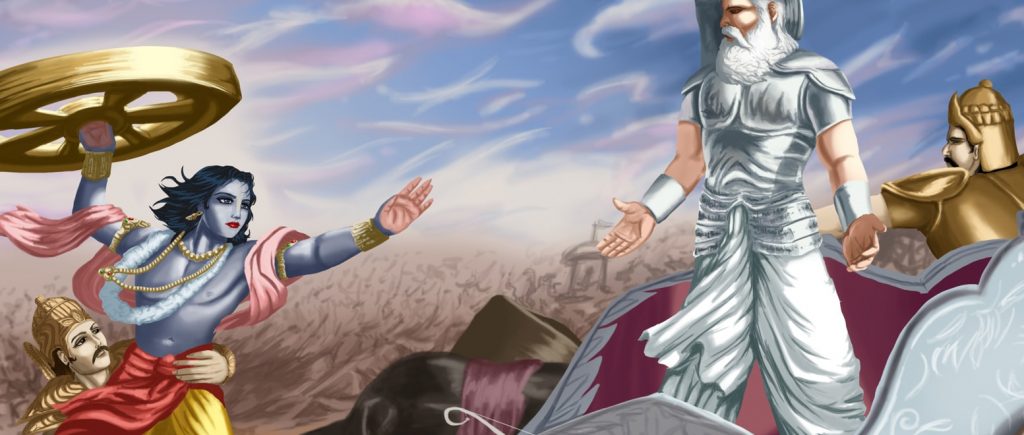
The main elements of a daily devotional practice include:
- Heart-centered prayer
- Kirtan or chanting meditation combined with active visualization
- Aarti-the offering of light – a brief ceremony that reaffirms the spirit of our devotional dedication
Karma Yoga – Dynamic Devotion
For the attainment of divine love, the Vedas state that there is only one rule and one prohibition that apply to bhakti yoga meditation. The rule is: “Always remember Radha Krishna.” The prohibition is, “Never forget Radha Krishna.”
This means that after our sitting meditation, our meditation should continue — while eating, sleeping, walking, working, talking, resting, and so on.
Wherever you are, all the time, whatever you are doing, remember your divine beloved and don’t forget Him! This simultaneous devotion and action is karma yoga. This state of devotional consciousness is cultivated over time with practice.
For example, in the old days street musicians with hand organs kept small monkeys. A monkey by nature is extremely active. How to make a monkey’s nature conform to sitting still, and that, too, in a confined space?

The musician’s technique was to first restrain the monkey with a 100-foot rope. If the monkey tried to go outside of this range, he was stopped. He thought, “Okay, I’ll jump around in a 100-foot area.”
When he was tied with a 50-foot rope he thought, “I went 100 feet yesterday, today I’m restricted to this much.” So he jumped around in a 50-foot area.
When the monkey was finally limited to only 1 foot of rope, he sat quietly, “Why should I drive myself crazy? I’ll just sit here.”
The human mind has this same monkey-like nature. It roams far and wide. Our goal is not to tame it’s active nature, but to train it to roam in a particular area. This is done by gently tying it with the devotional rope of love.
In sitting meditation we cultivate a feeling a devotional relationship with God. In active meditation we can continue this in three ways:
- Embed your intention — Every person has a mission that guides his life’s activities. For example, very few people like to work, but they do it because their mission is to support themselves or their family. While they are at work, although this motive is hidden deep in their mind, it still guides their decisions and actions.Similarly, when we firmly understand the purpose of our life is God-realization, this intention deeply embeds itself in the mind. If cultivated properly, this subconscious devotional intention remains in all our activities, even when we are sleeping.
- Feel divine presence — in sitting meditation we visualize and feel our relationship to God’s personal form. In activity, take hourly breaks for 30 seconds or a minute and with open eyes sense the presence of your worshipped form of God or Radha Krishna. Simply feel you are not alone. Imagine them near or far, sitting, standing or in any position, in any mood of love.
- Share your awareness — After visualizing God’s presence, either feel He is watching you or that you are showing Him what you are doing.
- Avoid wrong association — your associations and environment will affect your feeling of divine connection. Be mindful and avoid those situations that divert your devotional intention.
There is no restriction of time, place and activity for this remembrance. It can be done anywhere, at any time. You do not need to sit in a particular position or have closed eyes. This very simple practice will recall the blissful feelings of your seated meditation and help to stabilize your devotional experience.
Follow us on Facebook
Follow us on Twitter
Latest


Seven Vows and Steps (pheras) of Hindu Wedding explained
Views: 7,649 Indian marriages are well renowned around the world for all the rituals and events forming part of the...


Sari or Saree is symbol of Indian feminism and culture
Views: 6,483 One of the most sensual attires of a woman in India is undoubtedly the sari. It is a...


Atithi Devo Bhava meaning in Hinduism and India
Views: 5,825 Atithi Devo Bhava, an ancient line taken from the Hindu scriptures and was originally coined to depict a visiting person whose...


Sanskrit Is More Than Just A Method To Communicate
Views: 4,716 -By Ojaswita Krishnaa Chaturvedi anskrit is the language of ancient India, the earliest compilation of sound, syllables and...


Significance of Baisakhi / Vaisakhi
Views: 5,871 Baiskhi is also spelled ‘Vaisakhi’, and is a vibrant Festival considered to be an extremely important festival in...


Navaratri: The Nine Divine Nights of Maa Durga!
Views: 6,895 – Shri Gyan Rajhans Navratri or the nine holy days are auspicious days of the lunar calendar according...


History of Vastu Shastra
Views: 9,527 Vastu Shastra (or short just Vastu) is the Indian science of space and architecture and how we may...


Significance of Bilva Leaf – Why is it dear to Lord shiva?
Views: 9,115 – Arun Gopinath Hindus believe that the knowledge of medicinal plants is older than history itself, that it...


Concept of Time and Creation (‘Brahma Srishti’) in Padma Purana
Views: 9,501 Pulastya Maha Muni affirmed to Bhishma that Brahma was Narayana Himself and that in reality he was Eternal....


Karma Yoga – Yog Through Selfless Actions
Views: 8,768 Karma Yoga is Meditation in Action: “Karma” means action and “yoga” means loving unity of our mind with...

